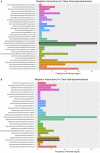Islands Within Islands: Bacterial Phylogenetic Structure and Consortia in Hawaiian Lava Caves and Fumaroles
- PMID: 35935195
- PMCID: PMC9349362
- DOI: 10.3389/fmicb.2022.934708
Islands Within Islands: Bacterial Phylogenetic Structure and Consortia in Hawaiian Lava Caves and Fumaroles
Abstract
Lava caves, tubes, and fumaroles in Hawai'i present a range of volcanic, oligotrophic environments from different lava flows and host unexpectedly high levels of bacterial diversity. These features provide an opportunity to study the ecological drivers that structure bacterial community diversity and assemblies in volcanic ecosystems and compare the older, more stable environments of lava tubes, to the more variable and extreme conditions of younger, geothermally active caves and fumaroles. Using 16S rRNA amplicon-based sequencing methods, we investigated the phylogenetic distinctness and diversity and identified microbial interactions and consortia through co-occurrence networks in 70 samples from lava tubes, geothermal lava caves, and fumaroles on the island of Hawai'i. Our data illustrate that lava caves and geothermal sites harbor unique microbial communities, with very little overlap between caves or sites. We also found that older lava tubes (500-800 yrs old) hosted greater phylogenetic diversity (Faith's PD) than sites that were either geothermally active or younger (<400 yrs old). Geothermally active sites had a greater number of interactions and complexity than lava tubes. Average phylogenetic distinctness, a measure of the phylogenetic relatedness of a community, was higher than would be expected if communities were structured at random. This suggests that bacterial communities of Hawaiian volcanic environments are phylogenetically over-dispersed and that competitive exclusion is the main driver in structuring these communities. This was supported by network analyses that found that taxa (Class level) co-occurred with more distantly related organisms than close relatives, particularly in geothermal sites. Network "hubs" (taxa of potentially higher ecological importance) were not the most abundant taxa in either geothermal sites or lava tubes and were identified as unknown families or genera of the phyla, Chloroflexi and Acidobacteria. These results highlight the need for further study on the ecological role of microbes in caves through targeted culturing methods, metagenomics, and long-read sequence technologies.
Keywords: cave microbiology; fumaroles; lava caves; microbial consortia; networks; taxonomic distinctness; volcanic environments.
Copyright © 2022 Prescott, Zamkovaya, Donachie, Northup, Medley, Monsalve, Saw, Decho, Chain and Boston.
Conflict of interest statement
The authors declare that the research was conducted in the absence of any commercial or financial relationships that could be construed as a potential conflict of interest.
Figures









Similar articles
-
The geomicrobiology of limestone, sulfuric acid speleogenetic, and volcanic caves: basic concepts and future perspectives.Front Microbiol. 2024 Mar 20;15:1370520. doi: 10.3389/fmicb.2024.1370520. eCollection 2024. Front Microbiol. 2024. PMID: 38572233 Free PMC article. Review.
-
Comparison of bacterial communities from lava cave microbial mats to overlying surface soils from Lava Beds National Monument, USA.PLoS One. 2017 Feb 15;12(2):e0169339. doi: 10.1371/journal.pone.0169339. eCollection 2017. PLoS One. 2017. PMID: 28199330 Free PMC article.
-
Comparison of Bacterial Diversity in Azorean and Hawai'ian Lava Cave Microbial Mats.Geomicrobiol J. 2014;31(3):205-220. doi: 10.1080/01490451.2013.777491. Epub 2014 Jan 30. Geomicrobiol J. 2014. PMID: 26924866 Free PMC article.
-
Cave microbial community composition in oceanic islands: disentangling the effect of different colored mats in diversity patterns of Azorean lava caves.FEMS Microbiol Ecol. 2015 Dec;91(12):fiv141. doi: 10.1093/femsec/fiv141. Epub 2015 Nov 11. FEMS Microbiol Ecol. 2015. PMID: 26564959
-
Life at extreme elevations on Atacama volcanoes: the closest thing to Mars on Earth?Antonie Van Leeuwenhoek. 2018 Aug;111(8):1389-1401. doi: 10.1007/s10482-018-1066-0. Epub 2018 Mar 20. Antonie Van Leeuwenhoek. 2018. PMID: 29557533 Review.
Cited by
-
Bridging Place-Based Astrobiology Education with Genomics, Including Descriptions of Three Novel Bacterial Species Isolated from Mars Analog Sites of Cultural Relevance.Astrobiology. 2023 Dec;23(12):1348-1367. doi: 10.1089/ast.2023.0072. Epub 2023 Dec 11. Astrobiology. 2023. PMID: 38079228 Free PMC article.
-
Microbiological exploration of the Cueva del Viento lava tube system in Tenerife, Canary Islands.Environ Microbiol Rep. 2024 Apr;16(2):e13245. doi: 10.1111/1758-2229.13245. Environ Microbiol Rep. 2024. PMID: 38643985 Free PMC article.
-
The geomicrobiology of limestone, sulfuric acid speleogenetic, and volcanic caves: basic concepts and future perspectives.Front Microbiol. 2024 Mar 20;15:1370520. doi: 10.3389/fmicb.2024.1370520. eCollection 2024. Front Microbiol. 2024. PMID: 38572233 Free PMC article. Review.
-
Reforestation regulated soil bacterial community structure along vertical profiles in the Loess Plateau.Front Microbiol. 2023 Nov 28;14:1324052. doi: 10.3389/fmicb.2023.1324052. eCollection 2023. Front Microbiol. 2023. PMID: 38088965 Free PMC article.
-
Microbial diversity of high-elevated fumarole fields, low-biomass communities on the boundary between ice and fire.Sci Rep. 2025 May 13;15(1):16600. doi: 10.1038/s41598-025-99782-3. Sci Rep. 2025. PMID: 40360685 Free PMC article.
References
-
- Barton H. (2015). Starving artists: bacterial oligotrophic heterotrophy in caves, in Microbial Life of Cave Systems, ed Engel A. S. (Berlin: De Gruyter; ), 79–104.
-
- Bauermeister A., Rettberg P., Flemming H. C. (2014). Growth of the acidophilic iron-sulfur bacterium Acidithiobacillus ferrooxidans under Mars-like geochemical conditions. Planet. Space Sci. 98, 205–215. 10.1016/j.pss.2013.09.009 - DOI
-
- Begon M., Harper J. L., Townsend C. R. (1998). Ecology: Individuals, Populations, and Communities, 3rd Edn. Cambridge, MA: Blackwell Scientific Publications.
-
- Bendia A. G., Lemos L. N., Mendes L. W., Signori C. N., Bohannan B. J. M., Pellizari V. H. (2021). Metabolic potential and survival strategies of microbial communities across extreme temperature gradients on Deception Island volcano, Antarctica. Environ. Microbiol. 23, 4054–4073. 10.1111/1462-2920.15649 - DOI - PubMed
Associated data
LinkOut - more resources
Full Text Sources
Other Literature Sources

